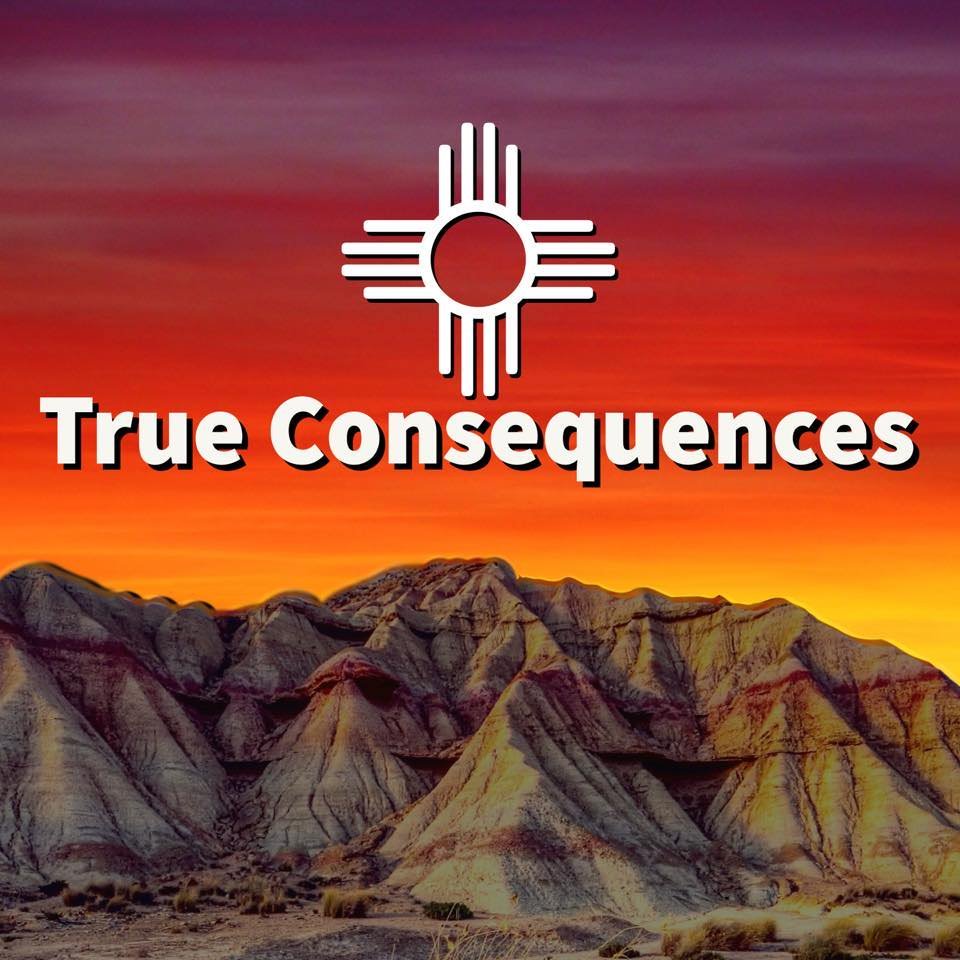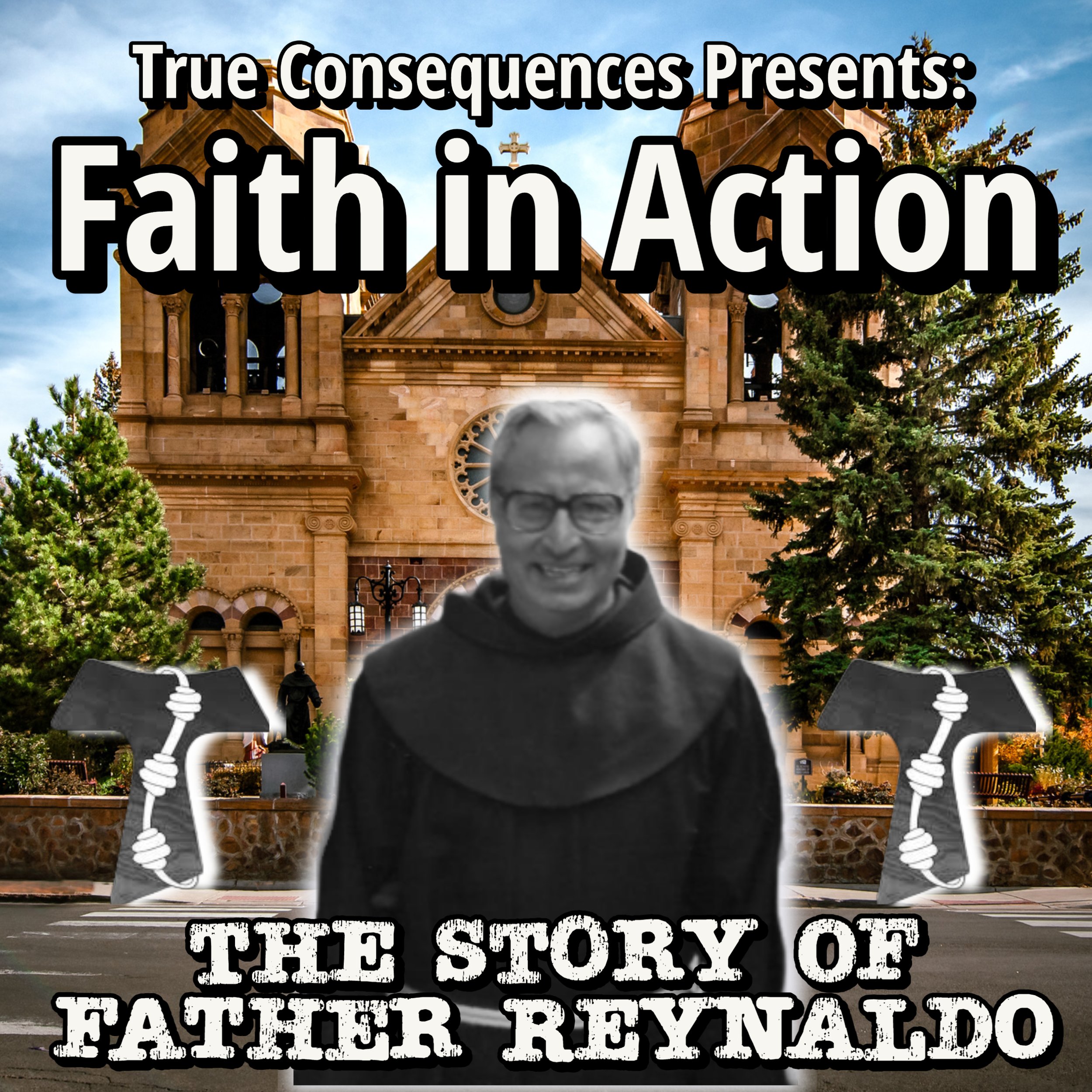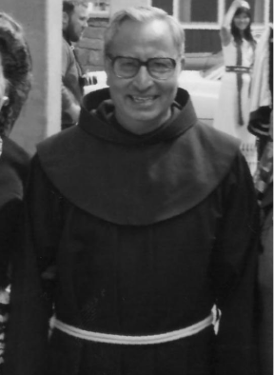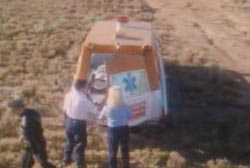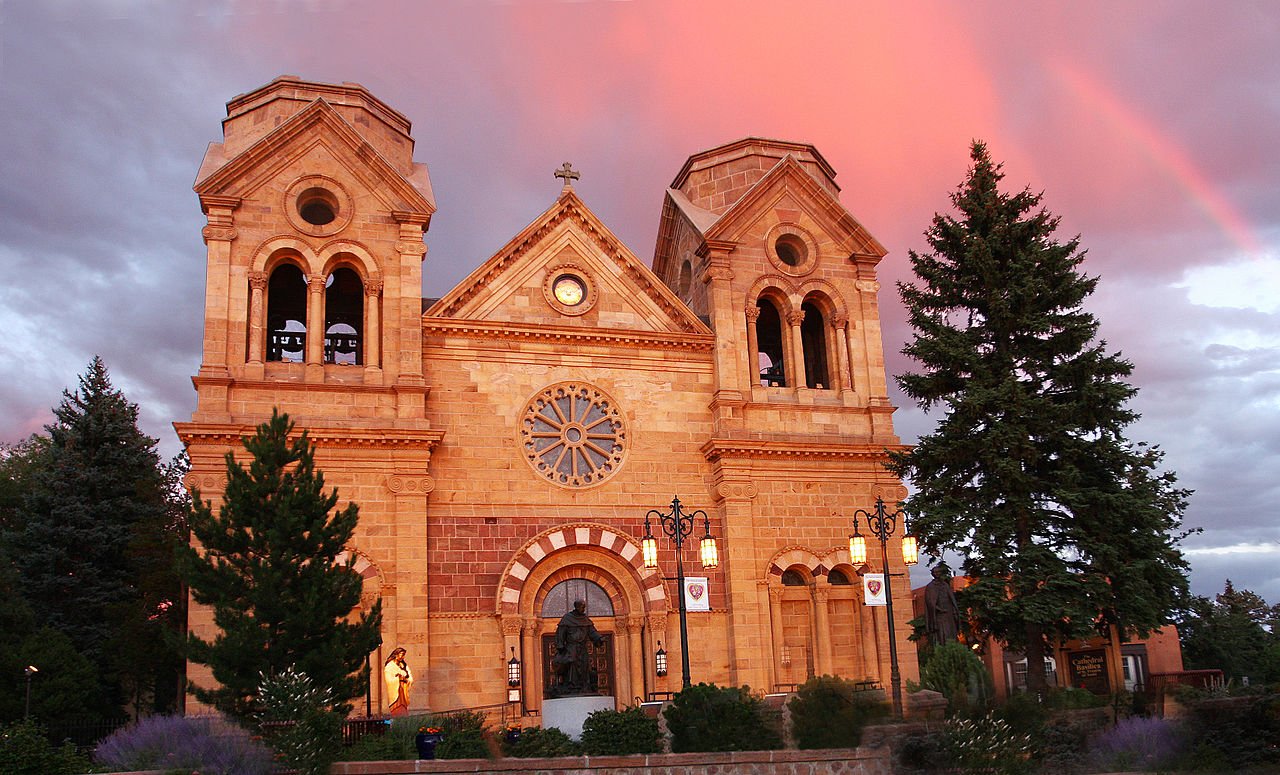Faith in Action - The Father Rivera Story
By Jackie Moranty - Producer, True Consequences
Father Reynaldo John Rivera answered the phone at St. Francis Cathedral church one night to hear a man on the other end asking him to meet him at a rest stop so he could perform Last Rites on the man’s grandfather who had had a heart attack. Father Rivera went to perform the sacrament and was found in the desert shot to death two days later. This murder has remained unsolved for 40 years.
Father Reynaldo John Rivera was born on October 29, 1924, in Santa Fe, New Mexico. Though we don’t know much about his childhood, we do know about his career as a priest. Very few children know what they want to be when they grow up, but John Rivera knew that he wanted to become Father Reynaldo John Rivera when he grew up. He wanted to be a priest, particularly, he wanted to be a Franciscan priest.
I’m going to talk about the history of the Franciscans for a minute because it’s a history that’s ingrained in who Father Reynaldo was, and the way he lived. He chose the Franciscan Order because its foundations are deeply rooted in helping the less fortunate, healing the sick and ministering to communities. The origins of the Franciscan Order dates back to 1210. It was founded by St. Francis of Assisi during the Medieval Period in Europe. During this time, religious men were typically from noble families, and they ministered in rural areas. Francis of Assisi was not a noble. His father was a cloth merchant in Assisi, Italy. Though affluent, they were not of noble blood.
Francis was raised to take up his father’s trade, but in his early twenties, he chose to become a religious man. His status as a merchant’s son wasn’t conducive to this quest at the time, so he thought about other paths that he could take. He thought about giving up his dreams of becoming a religious man and becoming a knight, but he knew that he wouldn’t be happy in that position. He could be a merchant like his father, but he wouldn’t be satisfied there, either.
He considered becoming a hermit, like so many other religious cast-offs, but he didn’t want to live alone in the countryside. He wanted to minister to the people, and he began by ministering to lepers. During this time in history, everyone was afraid of lepers. They were the “unclean”, and they were cast out of society. They were marked with sin. Francis didn’t see them any differently than the rest of the community. He loathed them, but he knew that if he wanted to be a man of God, he had to accept them and minister to them, just like he would minister to anyone else.
He went into the leper colonies and began to preach. He then began touching them, and finally he kissed their wounds. This was a time of great spiritual growth for Francis. He faced his fear and ministered to the sick.
When Francis was about 24, he was sitting in church, and he heard the crucifix speak to him. It told him to go to the outskirts of Assisi where he would find an old, abandoned church. His mission was to rebuild the church. Francis began begging in the streets for money and stones to rebuild the church. His father, Pietro Bernardone, was embarrassed by Francis’ behavior. The family was not poor, they had no reason to beg for anything. Many of the townspeople thought that Francis had lost his mind. He became a laughingstock, and this brought shame on the family. Francis’ father became even more angry when he found out that Francis had stolen some of the family’s cloth to sell so that he could have money to repair the church.
During a heated argument between Francis and his father, his father demanded the money back from the cloth that Francis had sold. This argument was public. It happened in the town square. Francis took all his clothes off and stood naked in the square. He told his father, “You can have whatever money is left, and you can have my clothing.”That’s when Francis announced that he wanted nothing more to do with Pietro Bernardone. He left his family behind and devoted himself to the repair of small churches.
Then in 1208, he found himself in another church. The priest was reading from the Gospel of Matthew. Christ was telling his followers that “they should go forth and proclaim that the Kingdom of Heaven is upon them, and they should take no money with them when they go to announce this message, that they should take no walking stick for the road, and that they should wear no shoes.”Francis took this message to heart and chose this life for himself. He dressed in worn clothing and became a travelling preacher. Over the year, Francis of Assisi gained a small band of followers. He called them the “fratres minores” or “the little brothers”. The term Friars is derived from the Latin term fratres, which means brothers.
Francis led his small group to Rome, where he requested, and obtained, a meeting with the Pope. During this meeting, he asked for permission to found a new religious order. The Pope approved the request and in 1210, the Franciscan Order received papal recognition. Francis passed away in 1226 and was canonized a Saint on July 16, 1228 by Pope Gregory IX.
The Franciscans believe in the importance of charity, benevolence, and selflessness. They do not believe in living lavishly while others live in poverty. The founding principles of Franciscanism include believing that God exists as a community of love through the Trinity, God is generous and loving, and that we are all brothers and sisters in God’s image.
In 1934, John Rivera was 13 years old, and he professed his faith in God. He was sent away from home to attend seminary schools. He graduated from high school in 1939 from St. Francis Seminary in Cincinnati, Ohio, then went on to college at Duns Scotus College in Southfield, Michigan. He then moved on to Holy Family Theology School in Oldenburg, Indiana. He was ordained a Franciscan priest in 1953. That was when he came home to New Mexico and stayed until his death in 1982. He was devoted to his home state. He and Father Miguel Baca were the first priests to ever be born in Santa Fe, both were Franciscans. Both had gone to seminary schools in Ohio. This was where they met and became friends. They would remain friends over the decades that they served the people of New Mexico.
It’s very important to understand the path to priesthood. Father Reynaldo spent nineteen years between seminary schools and his ordination. Those who choose to become Franciscans climb several steps in their spiritual journey before they reach Ongoing Formation, or the final step of a lifetime of servitude. After attaining a bachelor’s degree in theology and philosophy, those who profess their faith begin their path to priesthood.
The initial stage of Franciscan formation is called Postulancy. This is a time when the aspirant considers the Franciscan life. This stage consists of an orientation to Franciscan life and prayer and offers opportunities for ministry. Postulants are given resources to help them develop the psychological and emotional qualities necessary for ministry. This step lasts for about nine months.
The second step is called Novitiate. This program lasts a year and is centered around the beginner or novice considering his calling to the religious life. It is during this time that the novitiate studies the Franciscan Rule and General Constitutions, and he learns the vows of chastity, poverty, and obedience.
This is also the stage where he is given his Franciscan garment called a habit. This garment consists of a brown tunic and a hood called a capuche. The white cord that serves as a belt will normally have three knots in it. These knots symbolize the three vows, chastity, poverty, and obedience. However, at this stage, the belt will have no knots in it since the novitiate hasn’t taken his vows, yet.
During the third step, called the Post-Novitiate, the novitiate becomes a friar. He takes his vows and receives the three knots in his belt. These vows will be taken yearly until the friar is prepared to make his lifelong profession to God. This period lasts anywhere from three to nine years. During this time, he is integrated into the life of the Order of Friars Minor.
Often, you’ll see the letters OFM after a Franciscan priest’s name. OFM stands for Order of Friars Minor.
He learns ministerial and professional values based on his needs, gifts and calling. He will receive theological training, occupational training and technical training as well. He can study in the fields of nursing or social work.
After this training is complete, the friar petitions the Provincial Minister to be received into solemn vows. He publicly professes his vows of chastity, poverty and obedience for the rest of his life. This marks the beginning of full, lifelong membership into the Order of Friars Minor.
Formation is the last step. This is a friar’s lifelong commitment through living the word. These men continue to nurture future friars and strive to give a good example of an ever-growing Gospel life.This is where a friar shows his dedication in everyday life and ministers to his community while forming a deeper bond with God.
Father Reynaldo never stopped growing in faith. His passion and piousness would follow him from the time that he professed his faith in 1934 to the time that he was named a Guardian in 1976, and beyond to his death in 1982.
It's not unusual for priests to move from one church to another. This is part of their ongoing formation and growth in the church. Father Reynaldo was dedicated to every congregation that he ministered to. He learned to grow as a man of God while guiding his flock. This included ministering to other priests at Servants of the Paraclete in Jemez. Father Reynaldo ministered at Parkview from 1953 to 1956, then he went to St. John’s in Roswell from 1956 to 1957. From 1958 to 1959, he was ministering at Sacred Heart in Farmington. He spent two years at St. Francis in Gallup from 1958 to 1960, then went to the Jemez Pueblo where he ministered from 1960 to 1962. He was in Blanco from 1963 to 1967, then he was at Guadalupe in Clovis from 1967 to 1975. He finally went home to Santa Fe and St. Francis Cathedral where he remained from 1975 to 1982.
Every time priests moved to new communities; it was documented in the newspaper. Often there would be comments from community members stating that they were sad to see Father Reynaldo leave their community and giving a few details about all he had done while he was there. Father Reynaldo was lucky enough to spend his entire career in the state that he loved. The state that he bonded with, and the state that he called home. His roots were in New Mexico and Santa Fe in particular. He could be close to the family and community he loved so dearly.
Father Reynaldo’s life was well documented in newspapers from 1956 to his death in 1982. He officiated weddings and funerals, baptized babies, ministered to the sick, performed Last Rites and, it seems that every family would publicly thank him through small editorials in the newspaper over the years. He officiated Masses for his family members, as well. On June 12th, Father Reynaldo sang the Nupital Mass at his niece’s wedding. On April 25th, 1971, he performed the Mass at his nephew’s wedding. Both were beautiful double-ring ceremonies. Family came in from all over the country to watch both couples marry.
He was a guest speaker at Fiesta Reminiscences in 1968. He joined the Vespers at the Cathedral and the candlelight procession along the route to the Cross of the Martyrs on Fort Marcy Hill.
This Fiesta was a huge event with reenactments of Conquistadors, huge religious celebrations, and the finale of the burning of Zozobra, or Old Man Gloom.
This Fiesta began in 1914 as a way to cleanse the hearts of the people and bring joy into their lives. The first Zozobra was burned in a vacant lot in downtown Santa Fe. This finale was preceded by the candlelight procession and the Vespers.
Several pastors from different churches would speak during the weekend.
Now, the marionette stands close to 50 feet tall, and he’s stuffed with “papers of gloom”. Divorce papers, tax papers, maybe a warrant or two.
The streets are lined with artists plying their wares, and though there are religious celebrations happening over the weekend, they’re mostly attended by those who are members of the Church.
Father Reynaldo would get into some political controversy over the years. During his time as a priest, people looked to the opinions of religious leaders.
This meant that talking about current events and giving an opinion on them was part of ministering to the people.
He was a voice in New Mexico when Rowe vs. Wade was brought before the Supreme Court in 1973.
And locally, he stood up against liquor sales on Archdiocese property in July of 1981, just a year before his death.
The Archdiocese stood firmly against bars and restaurants that had opened on the property having liquor licenses and Father Reynaldo led the charge with several well-crafted letters to the city proclaiming the displeasure of the Archdiocese and St. Francis.
In the end, the city won out and bars and restaurants were allowed to serve at least beer and wine in their establishments.
Father Reynaldo wouldn’t give up, though. He and the other members of the Archdiocese threatened to veto the bill. They could do this since this was Archdiocese property and the businesses were leasing space. They again lost, and the bill passed. The City voted 6 to 1 in favor and the veto failed.
In October of 1981 he was interviewed in the Santa Fe New Mexican about his thoughts on intercultural marriage.
Interracial marriage was not accepted at the time. Most people married within their culture, and couples who wed outside of their race or culture were often shunned.
Father Reynaldo didn’t accept this idea and encouraged intercultural couples to grow together and ignore the prejudice that they may face.
He spoke about the acceptance that New Mexico couples enjoyed when it came to inter-racial and inter-religious marriages. He stressed that both partners should be accepting of the others’ culture and beliefs and that would get them through any prejudice they encountered.
He had seen this firsthand in his own family. His brother married a woman who was white, and his family was Hispanic.
Despite the cultural differences, the marriage thrived. The couple raised a family in Santa Fe and Father Reynaldo was an integral part of that family.
He ministered to the couple and gave them the advice they needed to become stronger through adversity. His sister-in-law would speak about his bond with her, her children and her husband. She would mourn his passing years after his death.
Not everything that he talked about would be controversial or political, though. And his actions showed that he didn’t have any prejudice. He offered whatever he could to his community. Not just the Catholics, but his whole community.
In 1975, the NAACP, the National Association for the Advancement of Colored People, which is still in existence today, wanted to offer karate classes and Father Reynaldo offered the banquet hall at Guadalupe church so they could do it.
Father Reynaldo wanted the kids in Clovis to have a safe and productive place to go as much as the NAACP did.
The year before, he offered the church’s school bus as transportation for the elderly to a picnic. Quite a few of the people attending the picnic were in nursing homes or could no longer drive.
In March of 1982, he judged the St. Francis School Pageant. Twelve girls competed in the pageant, and it was up to Father Reynaldo to choose one of them. He did so with words of encouragement and positivity for those who didn’t place in the contest and words of praise for the girl who won.
In the last article about him before his death, he was officiating Mass at the Easter celebration in Santa Fe. He also helped children find Easter eggs and participated in other festivities.
The pictures of the event show Father Rivera on the grounds of St. Francis. He’s surrounded by children and adults alike. He’s got a broad smile on his face.
This was in April of 1982.
It seems that whenever I read a community news article about him at any function, he was surrounded by people and smiling. He looked to be in his element. He wasn’t basking in the attention, but he seemed to be enjoying the moment. Speaking with the people in his community, smiling with them, laughing at their jokes, and ministering without preaching.
He was approachable, friendly, kind, and selfless.
His nature reflected in the news reports, the way his Brothers in the Church spoke about him and the way his family remembered him.
He was named as a Guardian of the Friary in 1976 and was called “one of Santa Fe’s Favorite Sons” by Brother Bruce Michalek, one of his Franciscan brothers in faith.
Brother Michalek was very close to Father Reynaldo, and he mourns his death to this day.
His sister, Nickie, would say that he was the most important source of spiritual guidance for his family. She passed away in 2018, and it was her mission to keep his name alive in hopes that his murder would be solved one day.
Helen Rivera, Father Reynaldo’s sister-in-law, said, “People just flocked to him, he was a very gentle man, a very pious man.”
Helen’s daughter was born with a serious disability. The child was frail and delicate.
Father Reynaldo was there. He held the child gently in his arms.
Father Reynaldo was dedicated to his work and his flock. Ministering to the people would be the last thing he would do before his death on August 5, 1982.
He led a beautiful life full of celebration, community and faith. His career spanned three decades and through it all, he was known to be one of the truly faithful.
References:
Father Reynaldo Show Notes:
https://www.findagrave.com/memorial/65326473/reynaldo-john-rivera
https://billingsgazette.com/father-john-kerrigan/article_e94a7577-c930-5e90-b6d7-fc0d41257014.html
https://www.onlyinyourstate.com/montana/famous-homicides-mt/
https://www.scribd.com/listen/podcast/528409147
https://www.sitcomsonline.com/boards/showthread.php?t=261493
https://www.kob.com/new-mexico/4-investigates-the-mysterious-murder-of-father-reynaldo-rivera/
https://factschology.com/mmm-podcast-articles/father-reynaldo-rivera-murder-1982
https://podles.org/case-studies/Reynaldo-Rivera-Murder-Case-Study.htm
https://www.scooterhammond.com/work/unsolvedmysteries
https://www.facebook.com/watch/?v=1214188665999666
https://www.youtube.com/watch?v=sUoocVhvgJY
https://www.insidehook.com/article/crime/unholy-mystery-murdered-priests
https://dbpedia.org/page/1980s_Franciscan_priest_murders
https://unsolvedmysteries.fandom.com/wiki/Father_Reynaldo_Rivera
https://flatheadbeacon.com/2021/03/23/the-vanishing-of-a-priest/
https://www.bishop-accountability.org/accused-by-last-name-k/
https://en.wikipedia.org/wiki/1980s_Franciscan_priest_murders
https://aleteia.org/2021/11/14/priests-and-religious-are-in-danger-in-many-parts-of-the-world/
https://www.youtube.com/watch?v=QWbRg9fqwIU
https://www.santafe.org/listing/cathedral-basilica-of-saint-francis-of-assisi/179/
http://mallonart.com/painting/santaFe/santaFe/timeline.html
https://www.sitcomsonline.com/boards/showthread.php?t=261493
https://peoplepill.com/people/1980s-franciscan-priest-murders
https://obits.arlingtonparkfuneralhome.com/obituaries/print?o_id=5331420
https://www.wondriumdaily.com/francis-of-assisi-and-the-origin-of-the-franciscan-order/
https://www.marian.edu/blog/posts/marian-blog/2018/02/02/what-is-a-franciscan
https://sbfranciscans.org/be-a-friar/formation/stages-of-formation/
https://socialism.com/fs-article/pope-francis-the-catholic-church-and-argentinas-dirty-war/
http://peacehistory-usfp.org/central-america-wars/
https://www.npr.org/2019/11/15/779628824/remembering-the-1989-massacre-of-jesuits-in-el-salvador
Newspapers.com:
The rest came from the police reports.
